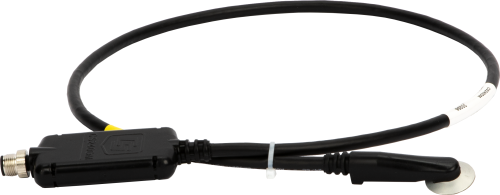This product is no longer available and has been replaced by: CS241DM.

| 利用できるサービス | |
|---|---|
| フリーサポート | 対応 |
概要
The CS240DM is a best-in-class smart sensor with a rugged, surface-mountable platinum resistive thermometer (PRT) that measures back-of-module temperature on solar photovoltaic (PV) panels. The CS240DM includes a new Campbell Scientific precision analog-to-digital, smart-sensor module that makes back-of-module temperature measurements that are among the most accurate measurements available today.
続きを読む利点と特徴
- Best-in-class measurement accuracy and technology
- Modbus RTU RS-485 digital serial communications
- Precision Pt1000 Class A sensing element
- Compliant with IEC 60751, DIN EN 60751
- Meets 61724-1 PV System Performance Standard
- Optional NIST traceable calibration certificate
- Purchased with any cable length
- Rugged design proven in more than 4,000 installations worldwide
イメージ








詳細
The CS240DM consists of a Pt-1000 Class A PRT encased in an aluminum disk. The disk protects the PRT, particularly during installation when pulled through conduit, and promotes heat transfer from the surface while minimizing convective heat loss to the surroundings. An adhesive tab on the disk fastens the CS240DM to the measurement surface. If the temperature may exceed 70°C, Kapton tape is also required to secure the probe.
The precision analog-to-digital, smart-sensor module is based on the CR1000X. The module design is optimized for the Class A PRT that minimizes self-heating and lead-wire resistance. Measurement electronics are surge protected, include 1200 V isolation, and are environmentally protected with a rugged over-molding featuring an IP65 rating. Data is differentially transmitted in cabling that is well suited for industrial energy applications with excellent noise rejection and high voltage, NEC outdoor, UV, UL, and NEC ratings.
The CS240DM provides PV stakeholders with highly accurate back-of-module temperature—even at long cable lengths—for use in power-performance modeling and simulation of solar energy applications. Back-of-module temperature is critical for any evaluation of effective irradiance and power conversion.
仕様
| Sensor | Platinum resistive thermometer (PRT) |
| System Uncertainty | ±0.3°C |
| Disk Material | Anodized aluminum |
| Surge Protection | 1200 V isolation |
| Supply Voltage of the Sensor | 5 to 30 Vdc |
| Power Draw | 15 mA |
| Compliance Information |
|
| Conforms with Electromagnetic Compatibility Directive | (EMC) |
| Conforms with the Restriction of Hazardous Substances Directive | (RoHS2) |
| Disk Diameter | 2.54 cm (1.0 in.) |
| Overall Probe Length | 6.35 cm (2.5 in.) |
| Overmolded Joint Dimensions | 5.72 x 1.12 x 1.47 cm (2.25 x 0.44 x 0.58 in.) |
| Weight | 90.7 g with 3.2 m cable (0.2 lb with 10.5 ft cable) |
Sensing Element |
|
| Precision | 1000 ohm Class A platinum sensing element (Pt-1000) |
| Accuracy | ±(0.15 + 0.002T)°C |
| Temperature Coefficient of Resistance | TCR = 3850 ppm/K |
| Long-Term Stability | Maximum Ro drift 0.04% (after 1000 h at 400°C) |
| Operating Temperature Range | -40° to +135°C |
Communications |
|
| Protocol | Modbus RTU protocol (over RS-485) |
| Format | 8 data bits, 1 stop bit, even parity as default (user-configurable) |
| Baud Rate | 19,200 bps as default (user-configurable) |
| Modbus ID | Last two digits of serial number as default (user-configurable) |
Cable |
|
| Description |
|
| Jacket Material | Black semi-gloss PVC, UL VW-1 sunlight resistant for outdoor use |
| Agency Approvals |
|
| Nominal Wire Diameter | 0.61 mm (0.024 in.) |
よくある質問
CS240DMに関するよくある質問の数: 4
すべて展開すべて折りたたむ
-
Even when three-pt calibration isn’t ordered, when we build the probes, we perform a final test to verify that they are reading within 0.3°C of our calibrated reference sensor at room temperature.
-
NIST traceability provides an assurance of accuracy. This is especially desirable in accordance with IEC 61724, which is a specification for monitoring solar energy generation that requires calibrated sensors.
-
Yes, it is NIST traceable.
-
A hot spot is caused if a cell in series is under-producing due to shading and gets reversed bias due to the other producing cells. For bifacial modules, as long as the front face is not shaded, all the cells should be producing and covering a small area on the back side and should not cause a severe mismatch.
ケーススタディ
プロジェクト概要 2021 年 5 月、Vertech は顧客である DEPCOM Power に太陽光発電 (PV) プラント向けの計装および制御ソリューションを供給するプロジェクトに着手しました。 Vertech は、太陽エネルギーを含むほぼすべての業界の企業に世界クラスの自動化ソリューションを提供しています。同社の設計には、業界の問題を解決し、運用効率、可視性、セキュリティを向上させる最新の自動化システム、監視制御およびデータ収集 (SCADA) システム、製造実行システム、運用技術ネットワークが含まれています。 ゴール このプロジェクトでは、Vertech は、顧客向けに PV......続きを読む
記事とプレスリリース
以下に記載
Privacy Policy Update
We've updated our privacy policy. 詳細はこちら
Cookie Consent
Update your cookie preferences. クッキーの設定を更新する

